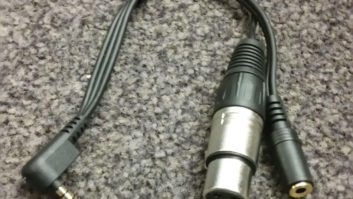I usually don’t write here about a product I also sell through my “day job,” for obvious reasons. But with permission of the editor of Radio World, I’d like to share information about a product that may give Workbench readers a bit more peace of mind.
(click thumbnail)Fig. 1: An Emergency Cable Kit will get you back on the air with exciter power. The GM will appreciate your resourcefulness.
Given the catastrophic calamities experienced by some engineers over the past couple of years, the topic of reliable backup systems is a popular one.
Simply having the means of getting your exciter on the air with a reducing cone and a length of 1/2-inch coax is an important first step to executing a reliability plan that keeps you on the air. This topic, in fact, was discussed at the NAB Radio Show’s Transmitter Workshop.
How much does this approach cost? It’s cheaper than you might think.
Although you can piece this together yourself, Dielectric Communications, my employer, offers two versions of an Emergency Cable Kit for 1-5/8- or 3-1/8-inch EIA flanged line. The kit is available from the company or its distributors. It consists of a step reducer and 25 feet of 1/2-inch foam line, with Type N male connectors installed on each end. The kit has a five-year warranty on the materials. The discounted price point on the 1-5/8 version is around $500. The 3-1/8 kit runs about $600.
This is cheap insurance when you consider the coverage a 30-watt exciter can provide. If you’ve got a newer 50-watt exciter, you’re that much more ahead of the game. This doesn’t sound like a lot of power, but when fed into an antenna 300 to 500 feet in the air, the coverage is amazing.
So when does such an emergency kit come in handy? If you don’t have a backup site at a different location, and your transmitter operates on three-phase power, you’re dead in the water if you lose a phase of electricity.
(click thumbnail)Fig. 2: A spare rectifier stack can speed repairs on a transmitter with a damaged power supply.
Don’t be lulled into complacency that this is just a summer “lightning” problem. Ice on power lines, or fallen trees laden with ice, make this a winter issue, too.
Let’s say you don’t have a backup transmitter, and you blow a hole in your plate blocker or lose a rectifier stack, or your tube bites the dust. Getting the exciter on the air quickly will make you a hero in the GM’s eyes, especially when she counts up the make-goods she can avoid due to your planning.
Having spares will help. I made it a policy that when transmitter parts failed, I bought two: one for now, the second to keep on the shelf for the next time. Perhaps you do the same. Stations with older transmitters can develop a nice spare parts kit as components fail.
As mentioned, major broadcast distributors offer the new emergency kit. This includes BE, BGS, Broadcast Connection, Geisler, Harris, RF Specialties and all the SCMS offices. Contact your preferred vendor and ask for the Emergency Cable Kit discussed here.


. . .
In my contract engineering days, one of my associate engineers prepared a unique cable assembly that lends itself to this discussion of backup redundancy. You may want to consider it.
Our customer was a small-market Class A FM, with a single-tube transmitter and no backup. By adding a four-port transfer switch, the transmitter output was fed into one port, and the antenna feed to the diagonal port. That left two ports unused. The exciter was routed through the unused ports of the transfer switch and back into the transmitter. Low-loss cable was chosen to minimize line loss through this run.
In normal operation, the exciter fed the transmitter through two ports of the switch. The transmitter similarly fed the antenna through the other two. When the transmitter failed, the switch was transferred so the exciter now fed the antenna directly.
Because the switch was interlocked, there was no way the transmitter could be brought up in this “emergency feed” mode. That is the caveat: You must properly interlock the transmitter so the transmitter does not operate without excitation or a load in the “emergency feed” mode.
With a remote transmitter site, this backup system worked well for many years until the station bought a new solid-state transmitter. The tube model was kept for backup, and the RF switch was already in place.
The only drawback to this “backup” was that the transmitter could not be tested while the exciter fed the antenna – not a problem, because the most common failure was a snake or mouse shorting out the power supply. While the exciter was on the air, the inside of the transmitter was inspected, the dead animal was removed and the transmitter usually came right up after transferring the switch.
I’ll be the first to admit this was cheap and dirty, but it worked; and for this small-market station, it was a lifesaver.
. . .
If you don’t have the budget for a transfer switch, consider a patch panel. These manual panels give you a less-expensive way of routing main and auxiliary RF paths.
Do you have an old antenna lying on the ground at one of your sites? Consider using it as a backup. Check with the manufacturer about removing a bay and retuning the antenna for single-bay use.
(click thumbnail)Fig. 3: Even a patch panel will get you back on the air quickly.
Better yet, look into budgeting for a new wideband single-bay for your backup. The wideband tuning may permit several FM channels to use the same antenna in an emergency. Granted, only one station signal can be fed at a time; but with multiple sites, the chance of losing all sites is not high.
Several FM transmitter manufacturers have designed frequency selection panels to switch exciter frequencies automatically. To really cover your market, feed this selection output into a 10 kW solid-state transmitter.
Backup systems don’t have to be fancy, just reliable. During an overnight maintenance session, intentionally drop a breaker and see what happens. If you have backup system instructions for your air staff, they should follow them flawlessly. With all the auto-programming available on remote-control systems like the Burk and Sine, you can leave the jock out of the picture altogether when it comes to selecting your backups.

. . .
Let me leave you with one bit of advice. Before you start depending on backup systems, make sure you understand them.
An engineer related that he toured a major-market station one afternoon. The new chief wanted to show him how quickly the transmitters would switch. Both were operating, the main into the antenna and the alternate main into the dummy load.
He hit the transfer switch control panel and – poof – smoked all four ports of the switch. The switch contact assembly burned, the switch wouldn’t turn and both transmitters shut down because of high VSWR.
The engineer assumed the switches, control panel and transmitters were interlocked. They weren’t. He was off the air in the middle of afternoon drive. You can imagine the impression this left on the GM.
Fortunately, the TV station down the hall had some elbows, and the switch was bypassed. But this was one hard lesson to learn. And with an audience watching.
Even when you’ve installed the interlock system yourself, test it with the transmitter’s high-voltage “off,” monitoring the interlock indicators for each mode of operation. It’s been my experience that some of the older switch control wiring can be squirrely. This is not a slam toward the manufacturers, but more so to the parade of engineers that’s been through the station over the years.
I saw one switch that was wired to shut down the transmitter when switching from transmitter “A” to transmitter “B.” But when switching back to transmitter “A”, the controller interlock circuit did not open. If the system had not been checked with the transmitter high voltage turned off – in all modes – we’d have smoked a switch, too.
If in doubt as how to wire transfer switch interlocks, pay the extra money to buy the controller, cables and factory wiring. Smoking a $50,000 transmitter because of crossed wires is not something you want on your résumé.












